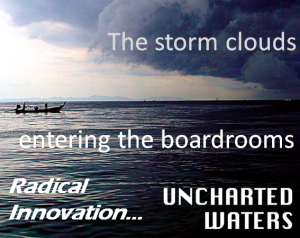 For me, there is never enough talked about innovation risk. Innovation is held back so often because the quantification of it’s risk cannot fit into an organization’s current assessment and measurements of risk.
For me, there is never enough talked about innovation risk. Innovation is held back so often because the quantification of it’s risk cannot fit into an organization’s current assessment and measurements of risk.
Innovation is often too intangible, full of unknowns as the very nature of anything new and different. Innovation risk leaves many executives very uncomfortable.
Organizations get uncomfortable when the words “radical” “intangible”, “unknowns” and other words like these when they form part of the conversation. It often starts to induce that “risk twitch” where that careful management for short-term performance might become threatened, or the manager feels any decision is ‘going out on a limb’ and possibly career threatening.
That growing uncomfortable feeling that innovation places their bonus at “risk” so they like to ring-fence innovation as much as possible. Now some of that ring-fencing is fine, you contain a risk to keep it manageable but most innovation does not constitute organization risk, yet it gets caught up in that risky fear that innovation seems to induce. Actually, if we were managing innovation at the core, our risk management for it would be very heightened and managed differently, but how many of our companies’ have innovation as their core?
So I always welcome discussion on risk and innovation. The more we talk about it the better for what is coming towards us. Continue reading “Optimism in Innovation, Thinking About Risk Differently”
